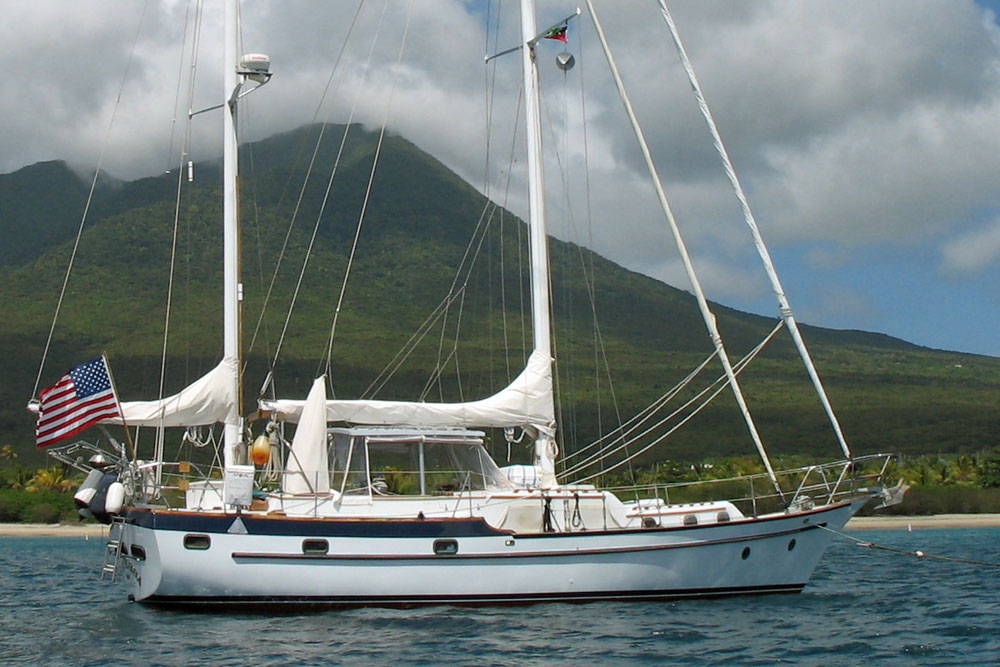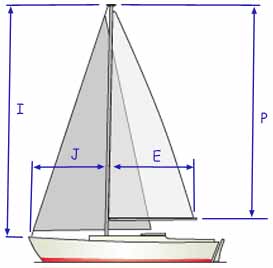- Home
- Cruising Yachts 40' to 45'
- CSY 44
The CSY 44 (Walk Through) Sailboat
Specs & Key Performance Indicators
The CSY 44 (Walk-Through), a heavy displacement cruising yacht, was designed by Peter Schmitt & Frank Hamlin and built in the USA by CSY Yacht Corp.
 Most were cutters, but a few - like the one above - were produced with a staysail-ketch rig
Most were cutters, but a few - like the one above - were produced with a staysail-ketch rigPublished Specification for the CSY 44 (Walk Through) Sailboat
Keel & Rudder Configuration: Fin keel with skeg-hung rudder
Hull Material: GRP (Fiberglass)
Length Overall: 44'0" (13.4 m)
Length on Deck: 44'0" (13.4 m)
Waterline Length: 36'0" (11.0 m)
Beam: 13'3" (4.0 m)
Draft: 6'6" (2.0 m), Shoal Draft version 5'0" (1.5 m)
Rig Type: Cutter
Displacement: 37,000 lbs (16,783 kg)
Ballast: 12,000 lbs (5,443 kg)
Water Tank Capacity: 165 gallons (625 liters)
Fuel Tank Capacity: 95 gallons (360 liters)
Hull Speed: 8.04 knots
Designer: Peter Schmitt & Frank Hamlin
Builder: CSY Yacht Corp. (Caribbean Sailing Yachts)
Year First Built: 1978
Year Last Built: Not specified
Number Built: 40
Options & Alternatives
Later versions of the CSY 44 Walkthrough Cutter sailboat were produced, the most notable of which was the CSY 44 Walkover. The essential differences between the original CSY 44 Walkthrough Cutter and the CSY 44 Walkover are:
- Deck Layout: The original CSY 44 Walkthrough featured an aft cockpit with a walkthrough design, allowing easy access from the cockpit to the interior. The CSY 44 Walkover, on the other hand, had a center cockpit with a walkover design, which provided a different spatial arrangement and potentially more privacy for the aft cabin.
- Interior Layout: The interior layout of the Walkover version was adjusted to accommodate the center cockpit design, which influenced the arrangement of cabins and living spaces.
- Rig and Hull: Both versions maintained the cutter rig and similar hull configurations, including the options for deep and shoal draft.
Sail Areas & Rig Dimensions

I: 54'0" (16.5 m)
J: 18'0" (5.5 m)
P: 47'0" (14.3 m)
E: 15'0" (4.6 m)
Total Sail Area: Approximately 965 ft² (89.7 m²)
Published Design Ratios
The Key Performance Indicators (KPIs)
- Sail Area/Displacement Ratio: 14.0
- Ballast/Displacement Ratio: 32.4%
- Displacement/Length Ratio: 354
- Comfort Ratio: 47.7
- Capsize Screening Formula: 1.6
- Sail Area/Displacement Ratio: With a ratio of 14.0, this sailboat would be considered underpowered. This suggests that the boat may not be particularly fast or agile, especially in lighter wind conditions. It would likely perform adequately but not exceptionally in terms of speed and manoeuvrability.
- Ballast/Displacement Ratio: At 32.4%, this ratio indicates that the boat has a moderate amount of ballast relative to its displacement. While not extremely stiff, it should exhibit reasonable stability and be able to handle wind and waves moderately well. However, it might not be as stiff or powerful as boats with higher ratios (40% or more).
- Displacement/Length Ratio: The ratio is 354, categorizing the boat as Ultraheavy Displacement. This implies that the boat is quite heavy for its length, giving it a strong presence in the water. Such boats typically have a smoother ride and can carry more supplies, making them favourable for long voyages. However, they generally require more sail area to achieve higher speeds and are not as responsive as lighter displacement boats.
- Comfort Ratio: With a Comfort Ratio of 47.7, this sailboat falls into the category associated with a heavy bluewater boat. This means that it is designed with comfort in mind, minimizing the pitch, roll, and corkscrew motions that can cause discomfort. This level of comfort is particularly advantageous for long-distance cruising and ocean voyages.
- Capsize Screening Formula: The value of 1.6 is well below the threshold of 2.0, indicating strong bluewater capability. This suggests that the boat is well-suited for ocean passages, with a design that minimizes the risk of capsizing in rough conditions.
Overall Summary:
The CSY 44 Walkthrough Cutter appears to be a robust, heavy displacement sailboat designed for comfort and stability in bluewater cruising. It is likely not a particularly fast or sporty vessel, but its construction makes it capable of handling long ocean passages with a high degree of safety and comfort. This boat would be ideal for sailors prioritizing comfort and safety over speed, especially in open-ocean conditions.
Here's how to calculate the KPIs yourself - without having to wrestle with the mathematics...
Design Ratios: Notes of Caution...
- The Sail Area/Displacement Ratio (SA/D): This ratio provides an estimate of the sail power relative to the boat's weight, which can indicate potential speed in various wind conditions. But it doesn't account for the efficiency of the sail plan, the rigging, or the skill of the crew. Real-world performance can vary significantly based on these factors.
- The Ballast/Displacement Ratio (B/D): This ratio gives an idea of the boat's stability and stiffness, which is crucial for handling and safety. But it doesn't consider the distribution of the ballast or the hull shape, both of which can greatly affect stability. A high B/D ratio alone doesn't guarantee a stable boat if the ballast is poorly distributed.
- The Displacement/Length Ratio (D/L): This ratio helps predict the boat's speed potential and its behaviour in different sea conditions. But it doesn't account for the hull design or the boat's overall weight distribution. Two boats with the same D/L ratio can perform very differently if their hull shapes are different.
- The Comfort Ratio (CR): This ratio estimates the boat's motion comfort in a seaway, which is important for long passages. But it doesn't consider the boat's interior layout, which can also affect comfort. Additionally, personal tolerance to motion varies, so a boat that is comfortable for one person might not be for another.
- The Capsize Screening Formula (CSF): This formula assesses the likelihood of a boat capsizing in heavy seas, which is critical for offshore safety. But it doesn't take into account the boat's handling characteristics or the skill of the crew. A boat with a low CSF can still capsize if poorly handled in severe conditions.
General Limitations
- Static Nature: These ratios are static measurements and don't account for dynamic factors like wave action, wind gusts, or crew actions.
- Simplification: They simplify complex interactions into single numbers, which can be misleading. Real-world performance is influenced by a multitude of factors that these ratios can't fully capture.
- Context: The context in which the boat is used (e.g., coastal cruising vs. offshore racing) can greatly affect how these ratios should be interpreted.
In summary, while these ratios provide valuable insights into the theoretical performance characteristics of a sailboat, they should be used as part of a broader assessment that includes practical experience, sea trials, and expert advice.
This article was written with the assistance of Gemini, a large language model developed by Google. Gemini was used to gather information, summarize research findings, and provide suggestions for the content and structure of the article.
Recent Articles
-
Passoa 47 Sailboat Review: Comprehensive Specs & Performance Analysis
Jan 04, 26 04:57 AM
Discover the Passoa 47, a legendary aluminium blue water cruiser by Garcia. Explore technical specifications, design ratios, and why its lifting keel is a game-changer for offshore sailors. -
Sailboat Wheel Steering Maintenance & Inspection Checklist
Dec 30, 25 02:32 PM
Keep your vessel’s helm responsive and reliable with our expert maintenance checklist. Master cable tensioning and system inspections to avoid mid-passage failures. -
Modern Boat Electronics and the Latest Marine Instruments
Dec 20, 25 05:27 PM
Should sailboat instruments be linked to the latest boat electronics as a fully integrated system, or is it best to leave them as independent units?












